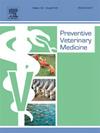Multiple antibiotic resistance of Salmonella Infantis in the Peruvian poultry production chain: Detection in birds, the farming environment, and chicken carcasses
IF 2.2
2区 农林科学
Q1 VETERINARY SCIENCES
引用次数: 0
Abstract
Poultry can act as a reservoir of Salmonella enterica serotype Infantis (S. Infantis) of clinical and epidemiological importance because it triggers foodborne disease outbreaks and presents antibiotic multiresistance. The present study aimed to determine antimicrobial resistance in S. Infantis isolates from poultry livers, litter and chicken carcasses from Lima, Peru, during 2022–2023. S. Infantis was isolated from 10.1 % (27/267), 4.7 % (4/86), and 8 % (2/25) of the bird, litter and carcass samples, respectively. All isolates showed resistance to nalidixic acid (NA). In addition, 94 %, 76 %, 70 %, 48 %, and 45 % of the isolates showed resistance to tetracycline (TET), amoxicillin (AMX), chloramphenicol (C), gentamicin (GEN) and trimethoprim/sulfamethoxazole (TS), respectively. All isolates showed susceptibility to imipinem and amoxicillin/clavulanic acid. Of the isolates, 93.9 % displayed multidrug resistance. The most frequent resistance pattern was C-AMX-NA-GEN-TET (24.2 %, n=8), determined even from carcass isolates, followed by C-AMX-NA-TET (18.2 %, n=6), and C-AMX-NA-GEN-TS-TET (12.1 %, n=4). The presence of these multidrug-resistant S. Infantis isolates is a threat to food safety and public health.
秘鲁家禽生产链中 Infantis 沙门氏菌的多重抗生素耐药性:在禽类、养殖环境和鸡肉中的检测。
家禽是肠炎沙门氏菌血清型 Infantis(S. Infantis)的贮藏地,具有重要的临床和流行病学意义,因为它会引发食源性疾病暴发并产生抗生素多重耐药性。本研究旨在确定 2022-2023 年期间从秘鲁利马的家禽肝脏、粪便和鸡肉中分离出的 S. Infantis 的抗菌药耐药性。10.1 %(27/267)、4.7 %(4/86)和 8 %(2/25)的禽类、粪便和尸体样本中分别分离出了 S. Infantis。所有分离物均显示出对萘啶酸(NA)的抗药性。此外,分别有 94 %、76 %、70 %、48 % 和 45 % 的分离物对四环素(TET)、阿莫西林(AMX)、氯霉素(C)、庆大霉素(GEN)和三甲双胍/磺胺甲噁唑(TS)产生抗药性。所有分离菌株都对亚胺培南和阿莫西林/克拉维酸有敏感性。93.9% 的分离株对多种药物产生耐药性。最常见的耐药模式是 C-AMX-NA-GEN-TET(24.2%,n=8),甚至从胴体分离物中也能确定;其次是 C-AMX-NA-TET(18.2%,n=6)和 C-AMX-NA-GEN-TS-TET(12.1%,n=4)。这些耐多药的 S. Infantis 分离物的存在对食品安全和公共卫生构成威胁。
本文章由计算机程序翻译,如有差异,请以英文原文为准。
求助全文
约1分钟内获得全文
求助全文
来源期刊

Preventive veterinary medicine
农林科学-兽医学
CiteScore
5.60
自引率
7.70%
发文量
184
审稿时长
3 months
期刊介绍:
Preventive Veterinary Medicine is one of the leading international resources for scientific reports on animal health programs and preventive veterinary medicine. The journal follows the guidelines for standardizing and strengthening the reporting of biomedical research which are available from the CONSORT, MOOSE, PRISMA, REFLECT, STARD, and STROBE statements. The journal focuses on:
Epidemiology of health events relevant to domestic and wild animals;
Economic impacts of epidemic and endemic animal and zoonotic diseases;
Latest methods and approaches in veterinary epidemiology;
Disease and infection control or eradication measures;
The "One Health" concept and the relationships between veterinary medicine, human health, animal-production systems, and the environment;
Development of new techniques in surveillance systems and diagnosis;
Evaluation and control of diseases in animal populations.
 求助内容:
求助内容: 应助结果提醒方式:
应助结果提醒方式:


